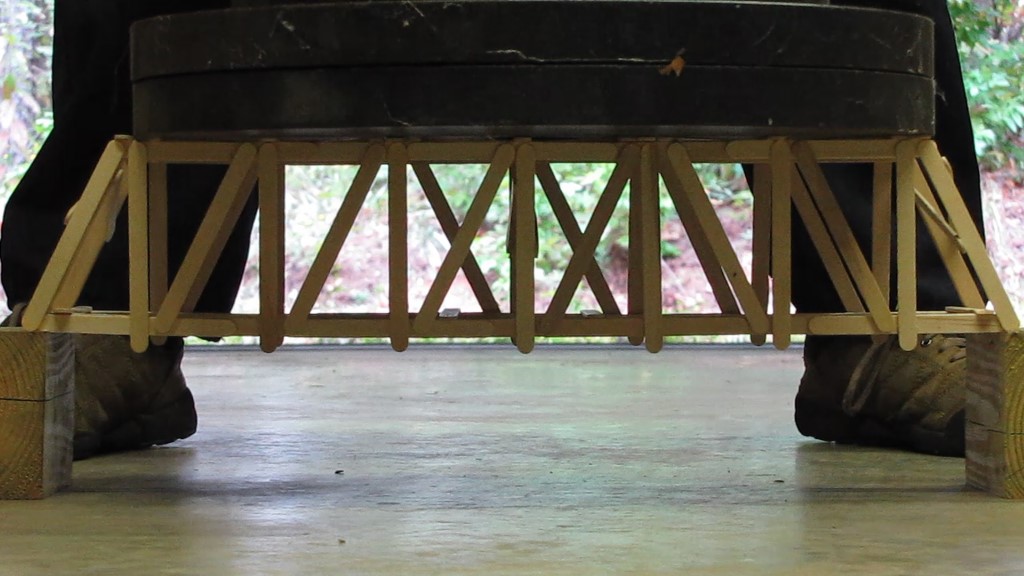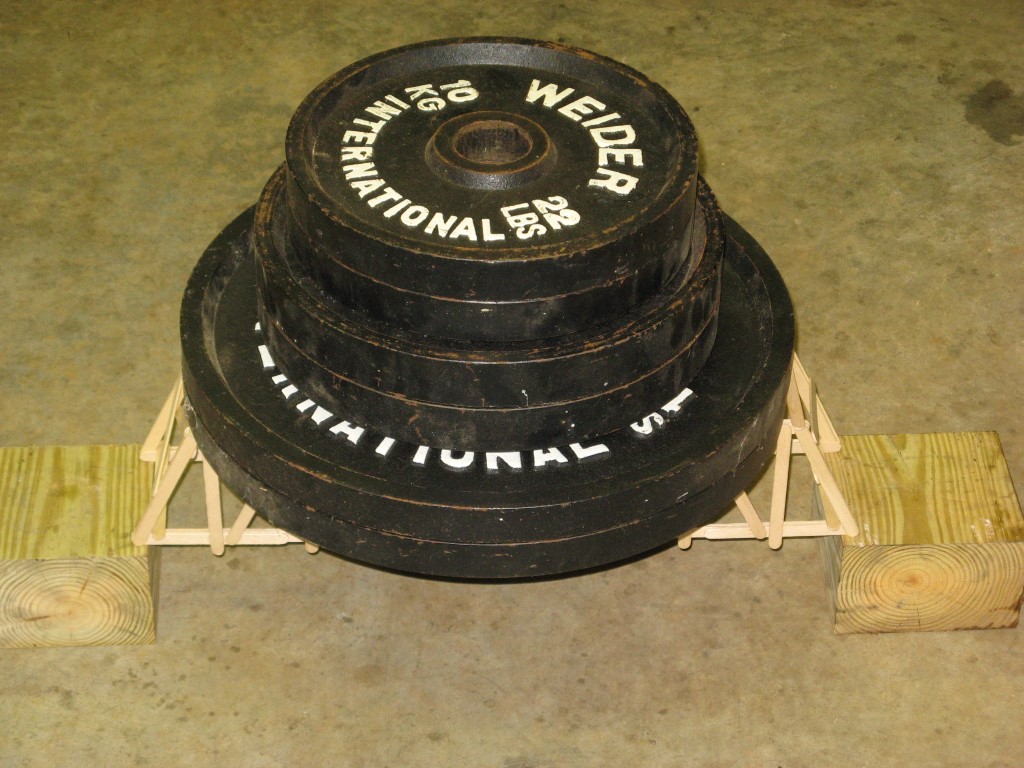The 100 stick popsicle bridge challenge is on. This Howe Truss bridge uses 99 popsicle sticks, spans 21 inches, and holds 200+ pounds. It’s efficiency score is 678. This is an updated version of my old “Popsicle Bridge #3” which was the same length, but slightly different in construction.
This bridge was built from completely un-modified popsicle sticks, Level 1 sorted. I used only Elmer’s White glue to join the sticks together. To test the bridge’s strength I raised the ends up off the ground with wooden blocks, and placed free weights from a weight set on top of the bridge. I did my best to keep the weights centered over the bridge and to place them down gently, and I do not think the bridge broke because of the method of testing.
These three photos show the progression of the bridge breaking. Watch the left side as it starts to fail.
Slow Motion of the Bridge Breaking



My conclusion based on these photos is that the lateral bracing on the left side popped off from the side of the bridge closest to you in the photo. This caused those angled popsicle sticks to twist, and the bottom chord starts to twist a little as well. I think it was a glue joint that came loose and started the chain reaction. The angled sticks on the ends may not have been perfectly even and square with each other, which would have caused a weaker joint.
The other possibility is a weak popsicle stick, which started to fail and then brought the rest of the bridge down with it. I only used a level 1 sort for these popsicle sticks, so this is possible.


Here we have a shot of the bridge holding some weights. Also you will see the analysis of this Howe Truss Bridge as shown by the free Bridge Designer program. This picture shows how the forces were spread out on the bridge at the time it failed. Notice how the forces are concentrated much higher in the middle of the top and bottom chords, as well as on the end angled members. This supports my thought that the left side angled members would have failed first. They were under a very significant load.
So now you have seen the video, and the photo evidence. How do you think the bridge broke first? What would you do to make this bridge better? Keep in mind that I was building under a 100 stick limit constraint.
Build this Howe Truss Bridge
If you are interested, you can purchase the blueprints to build this bridge in my store, and you can also buy a complete kit to build this bridge.


WOW so cool it holds more than 200 with just 99 Popsicle and Elmers glue
I Know its Pretty cool how it holds so much!!!!!
this is an awsome type of bridge:)
Wow! what a great bridge! I think I might try this sometime.
How tall is this? I’m doing a project and wanted to use this as a blueprint. (if you are OK with that)
This bridge was 4 inches tall.
Hi we are doing a school project and wanted to know what glue you used and if you can send us a diagram of how to build this bridge. Thank you
I used Elmers Glue All, but Weldbond would be stronger. You can get the blueprints here:
https://www.garrettsbridges.com/wp-files/store/#!/100-Stick-Bridge-21-Howe-Truss-Blueprints/p/264910/category=921015
it was awesome but how do you make it???
Garret, I have to make a Popsicle bridge with 150 Popsicle sticks that spans 60 centimeters. When tested, the load will be centered in the middle (bucket and sand). It has to hold 30 lbs.
I have tried several times building a bridge with a warren truss, but they all fail. I’m at wits end here, I have to hand it in next week. The bridges I made are all warren trusses (they never give out so far in my experiments), the Popsicle sticks along the bottom and top are all doubled together, the truss is a over truss, I made triangles on the top and bottom, and when I test I use my teachers way; keeping the load at center dangling underneath.
I know that there is no right way to build a bridge and that you have keep trying and trying. But, Can you please spare me a few tips and what I did wrong?
Amy, can you clarify what you mean by an “over truss”? I am not sure what that is. From watching your previous bridges breaking, have you noticed any particular weak spot? Are your popsicle sticks breaking first or are the joints failing? Are you sure that both sides of the bridge are perfectly parallel and perfectly vertical? If your bridge is leaning to one side even the slightest amount, it will break easily.
Garret, how much does the bridge weight? I really need this question answered. And if you don’t know… What do you think it would had been?
It was around 130 grams. No more than 150 grams.
He can i have a posible weight and more info so that i can try to replicate this project for my class studys. And if you have 3d design drawing that would be cool.
Tristen, you can get blueprints for this bridge here.
Thanks For the Help
if the weight was centerd on the bottom beams rather than plates set on top of the bridge would the weight support be the same or would the amount of weight the bridge is able to support decrease significantly? (significantly meaning more than 25 pounds
Unless there was a local failure, as in the area directly being in contact with the load, then the bridge should hold the exact same amount loaded from the top or the bottom.
This is so cool, wish the blueprints were free!
Would this bridge work better if each of the sections on top had an X made out of popsicle sticks instead of just some sections with an x?
I believe the failure in this bridge was a bad glue joint on the lateral bracing. Having an X might have helped with that simply because there would have been more joints to get more surface area for the glue.
How long is this bridge?
This bridge is 21 inches long.
How many pounds can this thing hold and for how long?
This model held over 200 pounds before breaking.
How long did you let it dry for
At least 24 hours.
How would you do it if you put the weight on the bottom and it pulled on it
Garret, How much would this Bridge hold if the bridge was held up by a tower of paddle pop sticks 15cm tall? if you haven’t tried this please do so and reply
if u could have made the both ends of double riveted joint including lacing with very first truss of both emd. may be it could have more efficiency
What was the name of the free bridge designer program u used?
It is called Bridge Designer. It is available for free, but it uses a web technology that is not considered “safe” and is blocked by most browsers.
How much did the bridge weigh after you made it?
I have a limit of 99 popsicle sticks and how can I reasure the sticks so they dont break without going over and I cant break the sticks or they have to stay whole.
How heavy was the bridge itself?
IS there a blue print for this?
2 things, I am in elementary school and I am building a popsicle stick bridge. Anyways, 1. what kind of glue did you use to hold it together, 2how long is the bridge?
It is 21 inches long.
Elmer white glue
Garrett,
I don’t want to burst your bubble but the way in which you tested this is completely incorrect. The only thing you tested was the compression capacity of the very end diagonal members. When I watched your video it’s very obvious that the way in which the bridge failed was that you buckled the end diagonal member. The member buckled out about its weak axis which then caused the first interior vertical to fail and then the whole thing was a progressive collapse. You didn’t test any of the interior chord or diagonals for their axial capacity because you loaded the bridge incorrectly. You used large circular steel weights that spanned the entire length of the top chord. Those steel weights are a hell of a lot stiffer than your wood bridge which means 95% of your bridge was experiencing zero load. All the load was being transferred down your lasts diagonal members to the supports. You need to point load your bridge at the center.
I found this while searching other Popsicle stick bridge builds and wondered how many poor souls followed your design only to be sorely disappointed.
Stephen, thanks for your insight. I’m mulling over what you said.
On a side note, this bridge’s design and the method of testing were based one of the more common practices for loading model bridges. For its purpose, I wouldn’t say it was incorrect but rather it might not be the best way to test a model bridge to get a true picture of its efficiency. Still, I’ll definitely keep this in mind when loading new bridges. Most everyone who has built this bridge has been pleased with its performance because the instructions make it easy to reproduce consistent results.
I have bought your kit. Is there a video of making the 99 popsicle bridge
There is no video at this time.
garrett I have a question can you type the instructions on how to make it.
Jason, the instructions are available for purchase from my store here:
https://www.garrettsbridges.com/wp-files/store/#!/100-Stick-Bridge-21-Howe-Truss/p/73782393/category=0
thank you
Do you have instructions of how to build the bridge?
Yes, they are available for purchase in my store
Hi,
Would there be any way for this 100 popsicle bridge to extend its length to about 25′? thanks
correction 25″
Garrett I have 2 major questions. 1. do you have to use elmer white glue and if you dont have to is their a negative using hot glue. 2. Does using dumbbells instead of plates also affect the bridge.
Hot glue is very flexible and I don’t recommend it. Using dumbbells would be harder to get a balanced load, but otherwise would be fine.